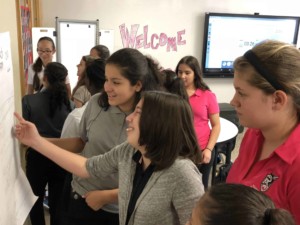Model Rockets
What is being done on the ground to create substantially better charters that use online as a tool for targeted learning for each student?
Here is an example of what Rocketship Education does in California. For background, we interviewed John Danner, CEO, Rocketship Education, last month.
If a school that typically runs on a four period day adopted the Rocketship hybrid school model, it would have:
*Three specialist teachers (in our example, three in Literacy, and one in Math) covering four first‐ grade classes
*One Learning Lab staffer
*Three classrooms
*One Learning Lab room
According to the document from Rocketship that contains this example, “In the same four‐period day, this means that a child spends three periods with a specialist teacher, and one period in Learning Lab using a computer and working on core skills strengthening according to his / her specific learning plan.” This does not take children away from the socialization and the teacher-student interaction that helps them achieve standards and then go beyond them. It’s the opposite. Administrators can focus on cost savings. Teachers can focus on all students, individually, and maintain smooth progress for entire classes. Time is not the invariable block anymore. Learning happens exponentially, because everyone is going at their own pace.
The document continues:
Benefits of the Hybrid School Model
The hybrid school model has three significant impacts on student achievement:
1. To better address each student’s unique learning needs (especially those in the bottom and top quartiles of achievement), use of computers allows us to individualize instruction more effectively than traditional schools.
2. Because 75% of the student’s day is in the classroom, and 25% is in Learning Lab receiving online instruction with hourly staff, Rocketship reduces staffing and facilities costs by 25%, resulting in an annual savings of $500,000 per year per school. This savings allows Rocketship to re‐allocate those resources into four areas affecting the quality of our program: Academic Deans, Leadership Training, Response to Intervention, and higher teacher salaries (20% higher than surrounding districts).
3. By reducing staffing by 25%, it is easier to fill all of our classrooms with top‐quality teachers.
We will get to a place when budget issues are so pressing that what seems pie in the sky actually looks like reality soon enough. The future is already here, as William Gibson famously said. It’s just not evenly distributed. Financial woes will bring a lot of people down to earth, including unions and district leaders who are getting more money than they need. Then, we can finally let the kids blast off.





0 Comments
Leave a Comment
Your email address will not be published. All fields are required.